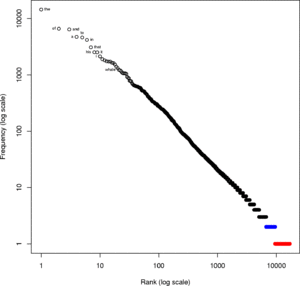Hapax legomenon facts for kids

A hapax legomenon (say "HAP-ax leg-OM-en-on") is a word that appears only once in a specific collection of texts. Think of it like a unique word in a book or a group of writings. The word comes from Ancient Greek. It means "something said only once."
If a word appears twice, it's called a dis legomenon. If it appears three times, it's a tris legomenon. And if it appears four times, it's a tetrakis legomenon.
What Are Hapax Legomena?
Hapax legomena are actually quite common. This is explained by something called Zipf's law. This law says that the more often a word appears, the higher its rank in a list of words. So, very common words appear a lot, and many words appear only a few times.
For large collections of text, about 40% to 60% of all the different words are hapax legomena. Another 10% to 15% are dis legomena. For example, in the Brown Corpus, which is a collection of American English texts, about half of its 50,000 words are hapax legomena within that collection.
How Are They Different from Other Words?
It's important to know that a hapax legomenon describes how often a word shows up in a text. It doesn't tell us about where the word came from. It also doesn't say how often people use the word when they speak.
This makes it different from a nonce word. A nonce word is a word made up for a special occasion. It might never be written down again. Or it might become popular and used a lot. A nonce word could even appear many times in the text where it was first used. But a hapax legomenon is simply a word that only appears once in a specific text.
Images for kids
-
The very long word "honorificabilitudinitatibus" from William Shakespeare's play Love's Labour's Lost.
See also
 In Spanish: Hápax para niños
In Spanish: Hápax para niños

